why were prehistoric animals so big?
Prehistoric animals, particularly during the Paleozoic and Mesozoic eras, grew to much larger sizes than most modern animals for several reasons:
- Abundant Food Sources: During these epochs, plant life was incredibly lush, with vast forests providing an immense biomass and high-energy food sources. Herbivorous dinosaurs and mammals could consume massive quantities of nutrient-rich vegetation, enabling them to sustain larger body sizes.
- Higher Oxygen Levels: It is hypothesized that atmospheric oxygen levels were higher during the Carboniferous and early Mesozoic periods, which might have facilitated increased oxygen intake and allowed for larger body sizes. More oxygen could potentially support the metabolic demands of larger animals.
- Evolutionary Arms Race: Predators and prey were locked in an evolutionary arms race. Larger predators could hunt larger prey, and prey species evolved to become bigger to deter predation, creating a cycle where both predator and prey grew in size.
- Lack of Modern Predators: Many giant prehistoric animals didn’t face the same types of predators that exist today. Without the pressures exerted by modern apex predators, species could grow larger without facing the same level of predation risk.
- Geological Stability and Climate: The Earth’s climate was more stable over long periods in the past, which could have favored the evolution of large-bodied species. Also, the continents were arranged differently, leading to larger contiguous habitats that could support large populations of giants.
- Genetic and Physiological Factors: Scientists also theorize that genetic and physiological factors played a role. For example, the growth patterns and regulatory mechanisms controlling body size in ancient animals might have differed from those of contemporary species.
Each of these factors likely played a role to varying degrees, contributing to the existence of megafauna during prehistoric times. However, the exact reasons for their gigantism are still subject to ongoing research and debate in the scientific community.



